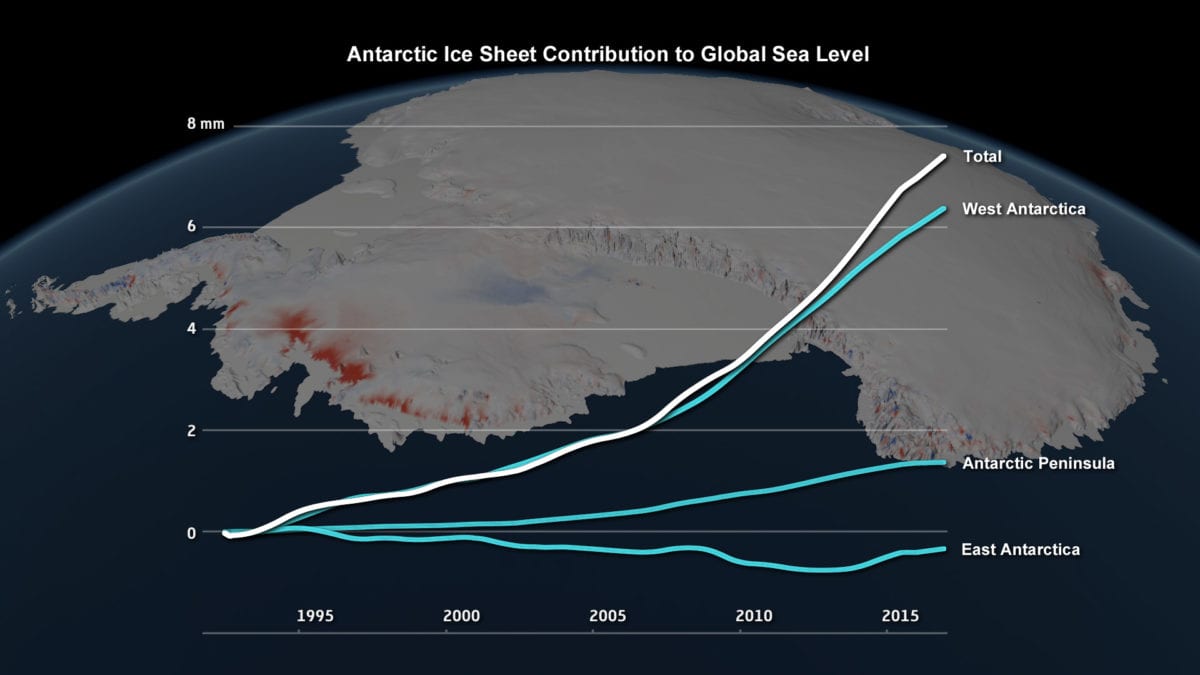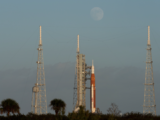
The Antarctic Peninsula from the air: although the mountains are plastered in snow and ice, measurements tell scientists that this region is losing ice at an increasing rate.
By Glynn Wilson –
WASHINGTON, D.C. — The continent of Antarctica on Earth’s South Pole is losing its ice cover so fast that NASA and the European Space Agency just sent out an email blast about a new study showing that the impact is already contributing to an increase in rising global sea levels in spite of a ban on federal agencies even talking about global warming or climate change by the Trump White House.
The new study published Wednesday in the journal Nature shows that ice losses from Antarctica have tripled since 2012, increasing global sea levels by 0.12 inch (3 millimeters) in that timeframe alone. According to the study funded in a major new international climate assessment by NASA and the European Space Agency, ice losses from Antarctica are causing sea levels to rise faster today than at any time in the past 25 years.
“Antarctica’s potential contribution to global sea level rise from its land-held ice is almost 7.5 times greater than all other sources of land-held ice in the world combined,” the study says. “The continent stores enough frozen water to raise global sea levels by 190 feet (58 meters), if it were to melt entirely.”
Knowing how much ice it’s losing is key to understanding the impacts of climate change now and its pace in the future. This latest study is the most complete assessment of Antarctic ice mass changes to date, the scientists say, combining 24 satellite surveys of Antarctica and involving 80 scientists from 42 international organizations.
“This is the most robust study of the ice mass balance of Antarctica to date,” said assessment team co-leader Erik Ivins at NASA’s Jet Propulsion Laboratory in the press release announcing the publication of the study. “It covers a longer period than our 2012 … study, has a larger pool of participants, and incorporates refinements in our observing capability and an improved ability to assess uncertainties.”

Changes in the Antarctic ice sheet’s contribution to global sea level, 1992 to 2017.
At 5.4 million square miles (14,000,000 square kilometres), Antarctica is the fifth-largest continent on the planet, nearly twice the size of Australia. About 98 percent of the continent is covered by ice that averages 6,200 feet (1.2 miles, 1.9 kilometers) in thickness.
The scientific team for this study looked at the mass balance of the Antarctic ice sheet from 1992 to 2017 and found ice losses from Antarctica raised global sea levels by 0.3 inches (7.6 millimeters), with a sharp uptick in ice loss in recent years. They attribute the threefold increase in ice loss from the continent since 2012 to a combination of increased rates of ice melt in West Antarctica and the Antarctic Peninsula, and reduced growth of the East Antarctic ice sheet.
Prior to 2012, ice was lost at a steady rate of about 83.8 billion tons (76 billion metric tons) per year, contributing about 0.008 inches (0.2 millimeters) a year to sea level rise. Since 2012, the amount of ice loss per year has tripled to 241.4 billion tons (219 billion metric tonnes) – equivalent to about 0.02 inches per year (0.6 millimeters) of sea level rise.
West Antarctica experienced the greatest recent change, with ice loss rising from 58.4 billion tons (53 billion metric tons) per year in the 1990s, to 175.3 billion tons (159 billion metric tons) a year since 2012. Most of this loss came from the huge Pine Island and Thwaites Glaciers, which are retreating rapidly due to ocean-induced melting.
While the scientists are apparently prohibited from saying it in relation to this study because of being muted by President Donald Trump and his advisers who want to continue raising a doubt cloud over science for the sake of industry profits, most scientists now say the vast majority of this warming, melting ice and rising sea levels are due to climate change from global warming because of the burning of fossil fuels by humans for energy.
According to the study, at the northern tip of the continent, ice-shelf collapse at the Antarctic Peninsula has driven an increase of 27.6 billion tons (25 billion metric tons) in ice loss per year since the early 2000s. Meanwhile, the team found the East Antarctic ice sheet has remained relatively balanced during the past 25 years, gaining an average of 5.5 billion tons (5 billion metric tons) of ice per year.
The datasets from (the study) are extremely valuable for the ice sheet modeling community, according to study co-author Sophie Nowicki of NASA’s Goddard Space Flight Center.
“They allow us to test whether our models can reproduce present-day change and give us more confidence in our projections of future ice loss,” Nowicki said.
Tom Wagner, cryosphere program manager at NASA Headquarters, hopes to welcome a new era of Antarctic science with the May 2018 launch of the Gravity Recovery and Climate Experiment Follow-on mission and the upcoming launch of NASA’s Ice, Cloud and land Elevation Satellite-2.
“Data from these missions will help scientists connect the environmental drivers of change with the mechanisms of ice loss to improve our projections of sea level rise in the coming decades,” Wagner said.
Meanwhile, the Trump administration is doing nothing to address the problem, leaving other nations around the world in Europe and Asia to take the lead in combating climate change as well as states such as California.
The satellite missions providing data for this study are NASA’s Ice, Cloud and land Elevation Satellite (ICESat); the joint NASA/German Aerospace Center Gravity Recovery and Climate Experiment (GRACE); ESA’s first and second European Remote Sensing satellites, Envisat and CryoSat-2; the European Union’s Sentinel-1 and Sentinel-2 missions; the Japan Aerospace Exploration Agency’s Advanced Land Observatory System; the Canadian Space Agency’s RADARSAT-1 and RADARSAT-2 satellites; the Italian Space Agency’s COSMO-SkyMed satellites; and the German Aerospace Center’s TerraSAR-X satellite.
For more information, check out this website for NASA’s Earth science missions.













